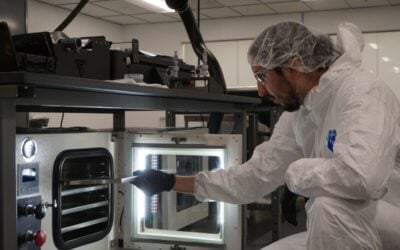Oxis Energy’s batteries are being trialled for military applications. Seen here is a lithium-sulfur battery which has been put through the ‘bullet test’ – literally having a bullet fired into it from point blank range. Image: OXIS Energy.
While lithium-ion is expected to hold its leading position as the battery chemistry of choice for at least the next decade, it would be wise to consider investing in its possible successors, according to Lux Research.
Cosmin Laslau, Lux analyst and one of a number of the firm’s team who contribute regular blog posts to this site, said that even while lithium-ion is itself improving, by 2030 the battery landscape is likely to be very, very, different. Solid state, lithium-sulfur and other chemistries have gradually come to prominence in the stationary storage space recently, with some appearing closer to market than others.
However, echoing predictions made to PV Tech Storage by Lux and another research firm, Navigant, some time ago in 2014, Laslau said that it is likely lithium-ion will not only hold its leading position over at least the next 10 years, but that improvements in the technology could keep it there until close to 15 years’ time from now.
While these improvements to li-ion will be incremental, next-generation batteries could in the meantime make leaps and bounds, and could collectively be worth US$10 billion by 2030.
Try Premium for just $1
- Full premium access for the first month at only $1
- Converts to an annual rate after 30 days unless cancelled
- Cancel anytime during the trial period
Premium Benefits
- Expert industry analysis and interviews
- Digital access to PV Tech Power journal
- Exclusive event discounts
Or get the full Premium subscription right away
Or continue reading this article for free
“Next-generation battery developers are pursuing technology improvements and mass-production scale-up, though incumbent Li-ion is still improving quickly, thanks to massive investments,” Laslau said.
‘Buying spree’
In August, Laslau had told PV Tech Storage that the acquisition by German manufacturing and engineering group Bosch of Seeo, a maker of solid-state batteries for the e-mobility sector, could mark the beginning of a “buying spree”. This time around, Lux has predicted that in the years 2030 to 2035, the market value of sold-state batteries in transport will leap from US$3 billion to US$42 billion.
Lithium-sulfur, conversely, will not do as well in mobility in that period, although it will also enjoy significant growth, jumping from a forecasted US$6 billion to US$29 billion. However, the two technologies’ fortunes will be completely reversed in electronics – lithium-sulfur could be worth US$12 billion by 2035 in that sector, a market share of 29%.
It is likely solid-state will on the other hand “see no significant adoption” in electronics, Cosmin Laslau claims, as it will be unable to push out lithium-ion as the latter technology makes those incremental advances. The energy density of solid-state will not be able to compete with the incumbent, Laslau said, only reaching a global market value of around US$2 billion by 2030 and unlikely to make the sort of forward advance seen in other areas.
The findings come from The next-generation battery roadmap: quantifying how solid-state, lithium-sulfur, and other batteries will emerge after 2020 by Lux Research. In the report, the analysts highlight a number of promising companies to watch, including thin-film battery maker Imprint Energy and Ilika Energy in solid-state and Britain’s Oxis Energy in the lithium-sulfur space.
Oxis Energy has been developing its batteries for some time and the devices have been picked up for trials in military applications due to their energy density being theoretically “five times higher” than li-ion. In the Lux report, Cosmin Laslau highlighted military applications as an early adopter market that investors should focus on, along with the wearable tech and internet of things (IoT) sectors.
On of Laslau’s colleagues at Lux, Lilia Xie, who has since left the company, blogged on an advanced battery technology for PV Tech Storage earlier this year, speaking with executives at 24M, a semisolid lithium-ion battery maker spun out of A123.





